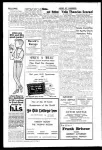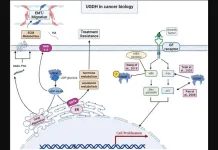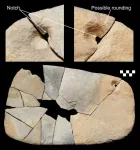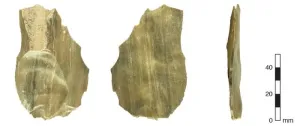(Press-News.org) Rice University alumnus Louis Brus (’65) has been awarded the Nobel Prize in Chemistry for the “discovery and development of quantum dots,” nanosized particles with unique properties “that now spread their light from television screens and LED lamps,” according to a Royal Swedish Academy of Sciences announcement today.
Brus, who started his undergraduate education at Rice in 1961, shares the distinction with Moungi Bawendi and Alexei Ekimov. Their work has been crucial to the development of nanotechnology, which has helped drive major computing advances and transformed electronics. The Swedish Academy highlighted Brus’ role as “the first scientist in the world to prove size-dependent quantum effects in particles floating freely in a fluid.”
While at Rice, Brus studied chemistry, physics and mathematics and developed “a love of history that has stayed with me to this day,” he said in a statement delivered when he received the 2008 Kavli Prize in nanoscience. Brus praised his undergraduate alma mater for its “rigorous, fundamental, yet broad education.”
“Rice was a wonderful place,” he said in the address.
“Today’s announcement recognizes Louis Brus’s pathbreaking, inspirational scientific career, one that has blended chemistry and physics in ways that have opened up entirely new areas of research and discovery,” Rice President Reginald DesRoches said. “We are proud of and salute our alum Louis and congratulate him and his colleagues for this well-deserved award.”
After earning his bachelor’s degree at Rice, Brus earned a Ph.D. in chemical physics from Columbia University in 1969 then served as a scientific staff officer at the U.S. Naval Research Laboratory in Washington, D.C. Upon concluding his service as a Navy lieutenant, Brus joined the AT&T Bell Labs in Murray Hill, New Jersey.
Naomi Halas, a Rice professor and nanophotonics pioneer, said she met Brus at Bell Labs, “where he was a distinguished member of the technical staff long before he moved to Columbia.”
“Lou has had the visionary ability to come up with entirely new ideas and the determination to realize them in the laboratory,” said Halas, Stanley C. Moore Professor, professor of electrical and computer engineering, biomedical engineering, chemistry, physics and astronomy and the director for the Smalley-Curl Institute and the Laboratory for Nanophotonics. “Along with his co-laureates, he created a link between nanomaterials and optics that never before existed. The transition from laboratory research to the real world ⎯ QLED TVs, for example ⎯ provides the strongest rationale for fundamental research.”
Brus, who is currently the Samuel Latham Mitchill Professor Emeritus and Special Research Scientist at Columbia, maintained ties to Rice through his relationships with faculty and service on Chemistry Department visiting committees.
“Lou’s pioneering work on quantum dots changed the way we see the world, and opto- electronics would not be where they are today without his contributions,” said Ramamoorthy Ramesh, Rice’s vice president for research and professor of materials science and nanoengineering and of physics and astronomy. “His accomplishments go hand-in-hand with a reverence for fundamental research and the role of universities in promoting discoveries.”
-30-
This release can be found online at news.rice.edu.
Follow Rice News and Media Relations via Twitter @RiceUNews.
Image downloads:
https://news-network.rice.edu/news/files/2023/10/TheRiceThresher_Louis-Brus.jpg
CAPTION: An announcement lists Louis Brus among the 1964 cohort of Will Rice Fellows, “selected on primarily academic achievement.” The Rice Thresher (Houston, Tex.), Vol. 51, No. 28, Ed. 1 Wednesday, April 29, 1964. (Image courtesy of the Woodson Research Center’s Digital Collections/Rice University)
https://news-network.rice.edu/news/files/2023/10/campanile1964rice-Louis_Brus.jpg
CAPTION: Louis Brus in Rice University’s yearbook, The Campanile, 1964. (Image courtesy of the Woodson Research Center’s Digital Collections/Rice University)
https://news-network.rice.edu/news/files/2023/10/campanile1965rice-266.jpg
CAPTION: Louis Brus in Rice University’s yearbook, The Campanile, 1965. (Image courtesy of the Woodson Research Center’s Digital Collections/Rice University)
Located on a 300-acre forested campus in Houston, Rice University is consistently ranked among the nation’s top 20 universities by U.S. News & World Report. Rice has highly respected schools of Architecture, Business, Continuing Studies, Engineering, Humanities, Music, Natural Sciences and Social Sciences and is home to the Baker Institute for Public Policy. With 4,552 undergraduates and 3,998 graduate students, Rice’s undergraduate student-to-faculty ratio is just under 6-to-1. Its residential college system builds close-knit communities and lifelong friendships, just one reason why Rice is ranked No. 1 for lots of race/class interaction and No. 4 for quality of life by the Princeton Review. Rice is also rated as a best value among private universities by Kiplinger’s Personal Finance.
END
Rice alum Louis Brus awarded Nobel Prize in Chemistry
Brus, co-laureates celebrated for discovering, developing quantum dots
2023-10-04
ELSE PRESS RELEASES FROM THIS DATE:
UGDH in clinical oncology and cancer biology
2023-10-04
“Given the potential challenges of directly inhibiting UGDH, therapeutic strategies may extend to targeting downstream pathways and upstream substrates.”
A new review paper was published in Oncotarget's Volume 14 on September 28, 2023, entitled, “UDP-glucose dehydrogenase (UGDH) in clinical oncology and cancer biology.”
UDP-glucose-6-dehydrogenase (UGDH) is a cytosolic, hexameric enzyme that converts UDP-glucose to UDP-glucuronic acid (UDP-GlcUA), a key reaction in hormone and xenobiotic metabolism and in the production of extracellular matrix precursors.
In this review, researchers Meghan J. Price, Annee D. Nguyen, Jovita K. Byemerwa, ...
Prehistoric people occupied upland regions of inland Spain in even the coldest periods of the last Ice Age
2023-10-04
Paleolithic human populations survived even in the coldest and driest upland parts of Spain, according to a study published October 4, 2023 in the open-access journal PLOS ONE by Manuel Alcaraz-Castaño of the University of Alcalá, Spain, Javier Aragoncillo-del Rió of the Molina-Alto Tajo UNESCO Global Geopark, Spain and colleagues.
Research into ancient hunter-gatherer populations of the Iberian Peninsula has mainly focused on coastal regions, with relatively little investigation into the inland. A classic hypothesis has been that the cold and dry conditions of inland Iberia ...
Antimicrobials don't appear to help pet dogs with uncomplicated diarrhea - so should likely be prescribed less often by vets - according to new causal inference study
2023-10-04
Antimicrobials don't appear to help pet dogs with uncomplicated diarrhea - so should likely be prescribed less often by vets - according to new causal inference study
###
Article URL: https://journals.plos.org/plosone/article?id=10.1371/journal.pone.0291057
Article Title: Target trial emulation: Do antimicrobials or gastrointestinal nutraceuticals prescribed at first presentation for acute diarrhoea cause a better clinical outcome in dogs under primary veterinary care in the UK?
Author Countries: UK
Funding: CP is supported at the RVC ...
Adoption of vegan dog and cat diets could have environmental benefits
2023-10-04
A new analysis estimates a variety of potential benefits for environmental sustainability—for instance, reduced freshwater consumption and greenhouse gas emissions—that could result from switching all pet dogs and cats in the US or around the world to nutritionally sound, vegan diets. Andrew Knight of Griffith University, Australia, presents these calculations in the open-access journal PLOS ONE on October 4, 2023.
The livestock industry has environmental impacts, such as land and freshwater ...
Being a vegetarian may be partly in your genes
2023-10-04
First fully peer-reviewed, indexed study to look at link between strict vegetarianism and genetics
More people would like to be vegetarian than actually are. ‘We think it’s because there is something hard-wired here that people may be missing’
Findings open the door to further studies that could have important implications regarding dietary recommendations and the production of meat substitutes
CHICAGO --- From Impossible Burger to “Meatless Mondays,” going meat-free is certainly in vogue. But a person’s genetic makeup plays ...
Hospital superbugs: Could one vaccine rule them all?
2023-10-04
What if a vaccine, given to patients just before or after arriving at the hospital, could protect them against lethal superbugs that lurk in healthcare settings?
That’s the premise behind an experimental vaccine invented by a USC-led team and patented by the university. Researchers designed the formula to prevent serious infections from drug-resistant pathogens. A new study shows that a single dose, administered in mouse models, put immune cells into "Incredible Hulk" mode, providing rapid protection against eight different bacteria and fungi species.
“It’s an early warning system. ...
New wound healing research by Wake Forest Institute for Regenerative Medicine produces full thickness human bioprinted skin
2023-10-04
WINSTON-SALEM, NC – October 4, 2023 - A research paper published today in Science Translational Medicine presents a significant breakthrough in the area of skin regeneration and wound healing by researchers at the Wake Forest Institute for Regenerative Medicine (WFIRM). The study, titled "Bioprinted Skin with Multiple Cell Types Promotes Skin Regeneration, Vascularization, and Epidermal Rete Ridge Formation in Full-Thickness Wounds," shows the successful development of bioprinted skin that ...
Analysis of grinding tools reveals plant, pigment and bone processing in Neolithic Northern Saudi Arabia
2023-10-04
In recent years, studies have revealed that the now-arid region of northern Arabia was once much wetter and greener, providing Neolithic human populations with access to both water and game. The present aridity of the region, however, preserves little organic matter, making a reconstruction of the Neolithic lifestyle difficult.
Now, in a new study published in the journal PLOS ONE, researchers from the Max Planck Institute of Geoanthropology, the National Research Council of Italy, Institute of Heritage Science (CNR ISPC), and University College London present use-wear ...
Early human migrants followed lush corridor-route out of Africa
2023-10-04
An international team of scientists has found early human migrants left Africa for Eurasia, across the Sinai peninsula and on through Jordan, over 80-thousand years ago.
Researchers from the University of Southampton (UK) and Shantou University (China), together with colleagues in Jordan, Australia and the Czech Republic(1), have proved there was a “well-watered corridor” which funnelled hunter-gatherers through The Levant towards western Asia and northern Arabia via Jordan.
Their findings, published in the journal Science Advances, support previous research conducted ...
A UCLA-led team may have found the key to stimulating human brown adipose tissue into combating obesity
2023-10-04
EMBARGOED FOR USE UNTIL:
2 p.m. (ET) on Oct. 4, 2023
--
A UCLA-led team of researchers has found nerve pathways that supply brown adipose tissue (BAT), a type of tissue that releases chemical energy from fat metabolism as heat – a finding that could pave the way toward using it to treat obesity and related metabolic conditions.
The researchers have for the first time detailed this nerve supply and provided examples of how manipulating it can change BAT activity, marking a first step toward understanding how to use it therapeutically, said ...
LAST 30 PRESS RELEASES:
Scientists use ultrasound to soften and treat cancer tumors without damaging healthy tissue
Community swimming program for Black youth boosts skills, sense of belonging, study finds
Specific depressive symptoms in midlife linked to increased dementia risk
An ‘illuminating’ design sheds light on cholesterol
Who is more likely to get long COVID?
Study showcases resilience and rapid growth of “living rocks”
Naval Research Lab diver earns Office of Naval Research 2025 Sailor of the Year
New Mayo-led study establishes practical definition for rapidly progressive dementia
Fossil fuel industry’s “climate false solutions” reinforce its power and aggravate environmental injustice
Researchers reveal bias in a widely used measure of algorithm performance
Alcohol causes cancer. A study from IOCB Prague confirms damage to DNA and shows how cells defend against it
Hidden viruses in wastewater treatment may shape public health risks, study finds
Unlock the power of nature: how biomass can transform climate mitigation
Biochar reshapes hidden soil microbes that capture carbon dioxide in farmland
Reducing saturated fat intake shows mortality benefit, but only in high-risk individuals
Manta rays create mobile ecosystems, study finds
Study: Mixed results in using lipoic acid to treat progressive multiple sclerosis
Norbert Holtkamp appointed director of Fermi National Accelerator Laboratory
New agentic AI platform accelerates advanced optics design
Biologists discover neurons use physical signals — not electricity — to stabilize communication
Researchers discover that a hormone can access the brain by hitchhiking
University of Oklahoma researcher awarded funding to pursue AI-powered material design
Exploring how the visual system recovers following injury
Support for parents with infants at pediatric check-ups leads to better reading and math skills in elementary school
Kids’ behavioral health is a growing share of family health costs
Day & night: Cancer disrupts the brain’s natural rhythm
COVID-19 vaccination significantly reduces risk to pregnant women and baby
The role of vaccination in maternal and perinatal outcomes associated with COVID-19 in pregnancy
Mayo Clinic smartwatch system helps parents shorten and defuse children's severe tantrums early
Behavioral health spending spikes to 40% of all children’s health expenditures, nearly doubling in a decade
[Press-News.org] Rice alum Louis Brus awarded Nobel Prize in ChemistryBrus, co-laureates celebrated for discovering, developing quantum dots










